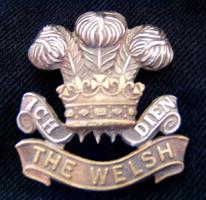The 24th Battalion, Welsh Regiment was created by the merging of these two proud Yeomanry Regiments January and March 1917. After training near Cairo, the battalion, which recruited its ranks chiefly from the counties of Pembroke, Carmarthen, Cardigan, and Glamorgan, crossed the Suez Canal and moved into Palestine as part of 231 Brigade, 74th (Yeomanry) Division, arriving just after the first battle of Gaza.

The division was in reserve during the second battle of Gaza. After some months of trench warfare and training, the battalion took part with the rest of the division in the battles of Beersheba and Sheria on 31 October 1917, and 6 November 1917, respectively. On the withdrawal of the Turks the brigade, embracing the 24th Welsh, after a long, and arduous march of three days, participated in local operations in the hills to the west of Jerusalem, and later operated in the successful attack on Jerusalem on 8 December 1917.
The battalion also figured in the successful counter-attack when the Turks took the offensive on 25 December 1917, for the purpose of regaining Jerusalem, and in February 1918 participated in the operations around Jericho and afterwards in local attacks advancing the line preparatory for the big attack of Nablus at the beginning of March 1918.
Shortly afterwards orders were received to proceed to France, and the battalion and the rest of the division disembarked at Marseilles on 7 May 1918. The battalion then assisted in the great push of the allies up to the signing of the Armistice.
After a period of training in Northern France, the 24th Welsh took over a portion of the line in front of St. Venant, just south of the Forest of Nieppe, and took part in the advance on Merville. Transferred to the Somme immediately afterwards, it was in the attack on Bouchavesnes, Dricourt, Villers-Faucon, Templeux-la-Fosse and Longavesnes, and subsequently in the Battle of Épehy, preceding the break-up of the Hindenburg Line.
After this engagement, the battalion, with the rest of the division, moved north, took over the line at Mont St. Aubers, and followed up the German retirement on the south of Lille to Tournai, taking Tournai on 9 November 1918 – two days before the Armistice. Since then the battalion was stationed at Grammont in Belgium, and the cadre disembarked at Dover in May 1919.
While in the Egyptian Expeditionary Force from January 1917 to April 1918, the 24th Welsh suffered the following casualties, from figures published in 1919:
Killed Wounded Missing
Officers 6 11
Other Ranks 59 239
While serving on the Western front from May 1918 to November, the casualties were:
Killed Wounded Missing
Officers 6 18 (3 gassed)
Other Ranks 56 388 (80 gassed) 11
There were in fact many more casualties than this, with some 225 men killed, admittedly a low figure by the standards of most of the other Welsh Regiment battalions, but nonetheless the story behind it is, hopefully, more interesting.
Honours won by the 24th Welsh included: Lieutenant Colonel Spence-Jones, the commanding officer, was made CMG and was awarded the DSO; Major J. B. H. Woodcock won the DSO; ten officers secured the MC and one gained the Bar to MC; whilst among the other ranks, two won the MSM, thirteen the DCM; and nineteen the MM. Seven officers and seven other ranks were mentioned in despatches.
My New Book
My new book, which will hopefully be published during August 2016 under the title of Welsh Yeomanry at War is available for pre-order from Pen & Sword and shortly from Amazon. Pleack click on the link below to pre-order a copy:
The book includes the following chapters:
Chapter 1: The Origins of the Battalion
Chapter 2: Mobilisation and Home Service
Chapter 3: The Situation in the Middle East
Chapter 4: The First Battle of Gaza
Chapter 5: The Second Battle of Gaza
Chapter 6: The Third Battle of Gaza
Chapter 7: Jerusalem
Chapter 8: The move to the Western Front
Chapter 9: Flanders
Chapter 10: The Somme 1918
Chapter 11: The Advance to Victory
Appendices: Awards to the Battalion
Appendices: Battle Honours
Appendices: Nominal Roll of Officers with Biographies
Appendices: Casualties of the 24th Welsh
Many of the officers were well known throughout south and west Wales, and were members of the landed gentry and local businessman and politicians. Some of the notable officers were Major General Ivor Philipps, a member of the Pembroke Yeomanry, who commanded the 38th (Welsh) Division: Lieutenant Colonel Odo Richard Vivian, Third Baron Swansea, who was a member of the Glamorgan Yeomanry: Major Stewart Loudon Shand, VC, a member of the Pembroke Yeomanry who won the Victoria Cross on the opening day of the Battle of the Somme: Lieutenant Colonel Delmé Davies Evans, a Major of the Pembroke Yeomanry who commanded the 5th Battalion, Lincolnshire Regiment in France; and Lieutenant Colonel Cecil John Herbert Spence-Jones (later Spence-Colby) who commanded the battalion throughout the war, later becoming High Sheriff of Herefordshire.